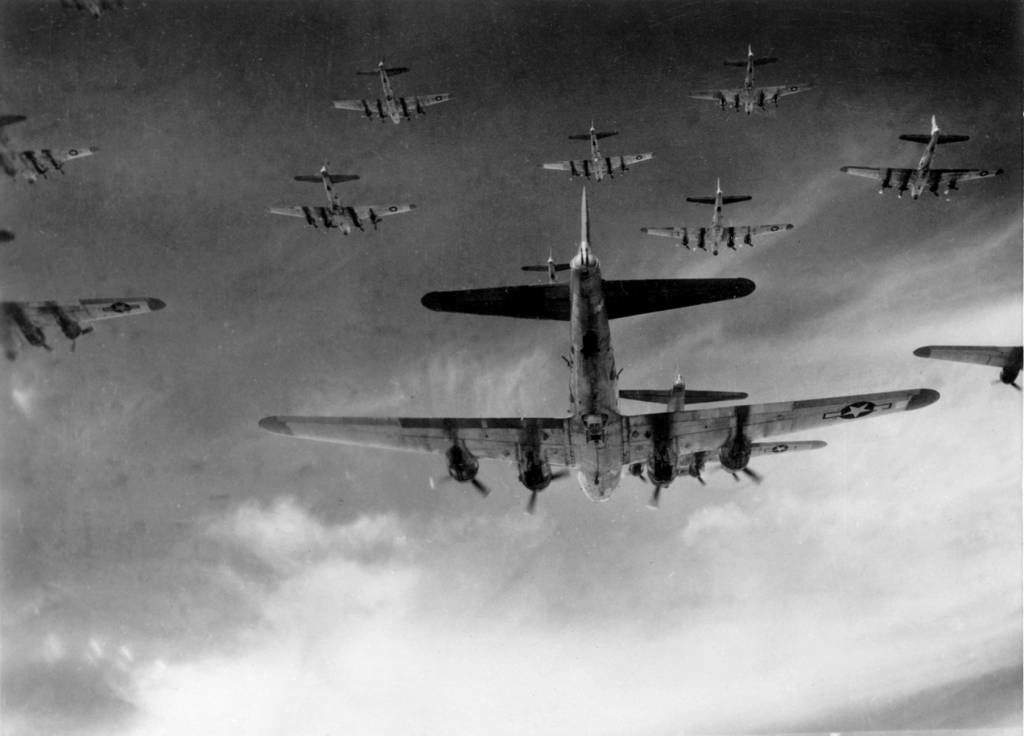
The Allied strategic bombing offensive against Nazi Germany remains the costliest aerial conflict in military history. With the US Army Air Forces bombing by day and the British Royal Air Force bombing by night, nearly 200,000 airmen lost their lives (with the British at 55,500) alongside some 500,000 European civilians. Official accounts differ in their statistics for the United States (35,844 out of 52,173 or 30,099 out of 40,061), but regardless, 70% of all American airmen lost in the Second World War were killed in the skies over Europe. These numbers are staggering. Not only does this mean that more American airmen were killed in World War Two than sailors or Marines, but it also means that, throughout all of US history, 95% of all American airmen killed-in-action were Second World War veterans – over half of which were bomber crews over Europe. And to top it off, all this was at a time when the Air Force was still a branch of the Army.
The bloodiness of these campaigns demand remembrance and it is our intention to do just that. May the sacrifices of those lost, in the air and on the ground, never be in vain.
The concept of strategic bombing was relatively untested prior to the Second World War and the nations who attempted it did so largely on the basis of trial and error. The Great War (1914-1918) had first given rise to the idea, with Germany surrendering to the Allies not because of an invasion, but because its economy crashed and its people revolted. This fact, combined with the earlier panic of British and French civilians toward Zeppelin bombing raids, led to the inescapable conclusion that aerial bombardment, properly and sufficiently applied, might could avert another long and costly war. For many airpower theorists, strategic bombardment resembled MG William Tecumseh Sherman’s march in the American Civil War: the more the people are made to suffer, the quicker the war can be brought to a halt. The US concept, however, was far more restrained. The stock market crash of 1929 and the resultant economic depression gave rise to the “industrial-web” theory, the idea being that the removal of the proper industry might cripple another nation’s entire ability to wage war. Both of these concepts were tested in the Second World War.

LTG Jacob L. Devers, CG ETO, and MG Ira C. Eaker, CG 8AF, pose with the Memphis Belle (41-24485, 91BG)
The US strategic bombing effort against Nazi Germany began on 17 August 1942 with the US Eighth Air Force in England (later joined by the Fifteenth Air Force in occupied-Italy). For the next ten months US heavy bombers struck submarine and naval bases on the coasts of Germany and occupied-France, slowly but steadily building their numbers. These operations provided a steep-learning curve, with American units having to improvise new formations, armaments, and tactics along the way. Most serious were the insufficient numbers of escort fighters, the few fighters available lacking the range to escort the bombers all the way to their targets and back. This lack of fighters, combined with too few replacement aircraft and crews for the bombers, resulted in unusually high loss-rates, so much so that the 8AF commander, MG Ira C. Eaker, declared the following year that any airman who completed 25 combat missions was entitled to return to the US. The first aircrew to achieve this feat, the Memphis Belle, did so on 19 May 1943.
Five days later, the German government halted its anti-shipping campaign in the Atlantic, acknowledging the success of British and American naval anti-submarine efforts. This fact, combined with the announcement that the Allied invasion of Europe was to begin in 1944, meant that the bombing offensive was required to achieve air superiority before that time. On 25 May, Eaker presented to US Pres. Franklin D. Roosevelt (D-NY), British PM the Rt. Hon. Winston L. Spencer-Churchill (CP), and the Combined Chiefs of Staff his plan for achieving this goal. This plan, known as the “Combined Bomber Offensive,” called for US counter-air campaign targeting German aircraft and ball-bearing factories. Ball-bearings, crucial to the operation of nearly all industrial equipment, were in short supply in Germany, its production centered almost entirely around the city of Schweinfurt. The destruction of the Schweinfurt ball-bearing plants, it was hoped, might have such a catastrophic effect on the German military and economy and might even alter the course of the war.

Messerschmitt Bf-109 fighters under construction in Regensburg, Germany.
This air superiority campaign, known as POINTBLANK, began on 14 June 1943. At first the strikes were centered against closer cities like Bremen – a major hub of German aircraft production. On 28 July US fighters for the first time used jettisonable external fuel tanks (or “droptanks”), escorting a strike against Hamburg. These tanks increased the combat radius of the Republic P-47 – the most common fighter at the time – from 230 miles to 340 miles. The increasing range of US fighters allowed the US offensive to build up steam and it was enough of a serious threat that General der Jagdflieger (Inspector General of Fighters) Adolf J. F. Galland and Reichsminister für Bewaffnung und Munition (Reich Minister for Armaments and Munitions) B. K. H. Albert Speer – two of the more competent leaders in German high-command – personally appealed to Führer Adolf Hitler on the subject. Unfortunately for the US, the largest centers for German aircraft production were far outside the range of US fighters, and Schweinfurt was little better: Stuttgart (454 miles), Regensburg (463 miles), and Schweinfurt (567 miles). To achieve POINTBLANK’s goal, the US 8AF needed to depend on feints, surprises, and carefully-timed fighter rendezvous points.
It was hoped that a plan for a meticulous series of strikes against these three cities, cooperating with USAAF units stationed in occupied-Libya, might solve this problem. Called Operation JUGGLER, US bombers were to strike these targets simultaneously, with the Regensburg-force flying on to occupied-Algeria and the Schweinfurt-force returning to England; as such, one force would fight their way in, the other would fight their way out. It was hoped that this plan, with escorts meeting the bombers along portions they could reach and a coordinated strike by North Africa-based bombers against Wiener Neustädt, Austria, might spread German forces thin enough that the bombers would only have to defend themselves for a small period of time.
Weather, ever the bane of air operations over Europe, prevented this from happening.
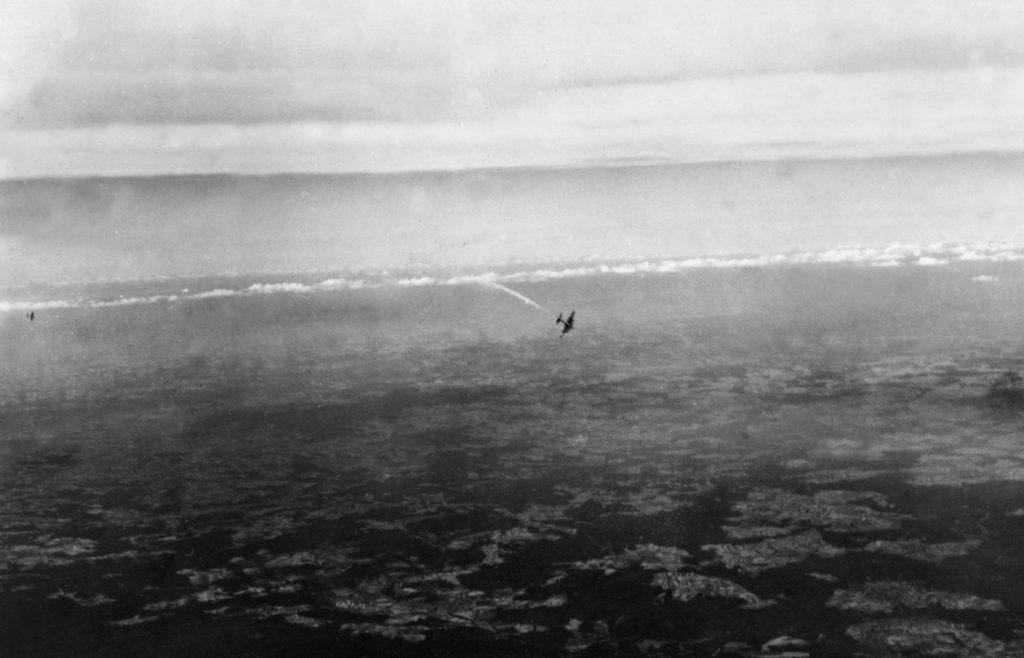
This photo, taken from Lucky Thirteen, shows a B-17 spinning out of control over Schweinfurt, the fighter that shot it down following nearby.
On 13 August 1943, 114 Consolidated B-24s based in North Africa launched their strike against Wiener Neustädt, bombing the city’s Messerschmidt aircraft factories. Still recovering from a costly strike against Ploesti, Romania two weeks prior, the attacking force was smaller than hoped though surprisingly effective. The US forces in England launched their Regensburg/Schweinfurt attack on 17 August.
The airstrike was a disaster.
The weather was characteristically poor and the two combat wings took off with such a large gap between them that the German fighters were able to rearm and refuel between attacks. Similarly, almost none of the US fighter units were able to takeoff and rendezvous with their wards. 60 bombers were lost on the strike (600 airmen missing) and another four were damaged beyond repair. At a time when 4% per sortie was considered the highest manageable loss rate, the 8AF lost 17% of its force in a single day. In the days that followed, post-strike reconnaissance confirmed that only one of the targets, Regensburg, was effectively bombed. They would have to go back.
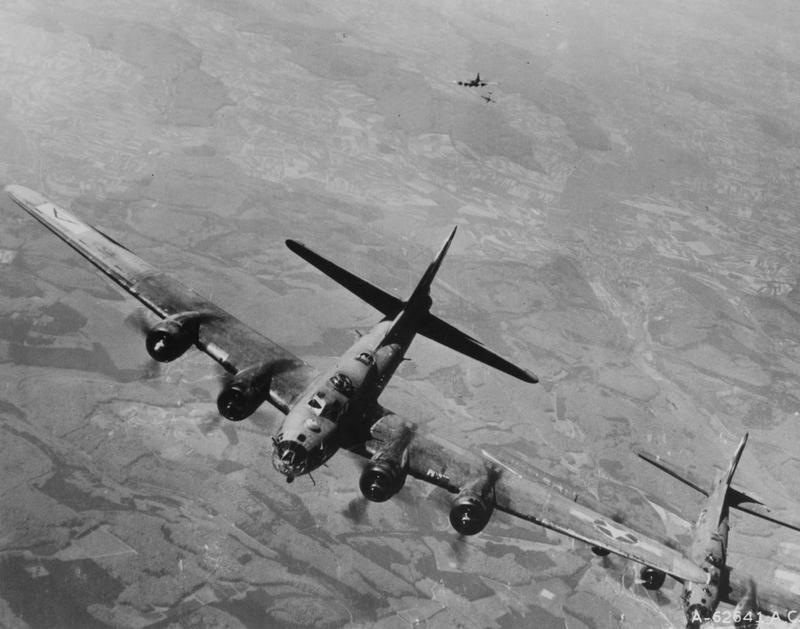
German fighters attack a B-17 formation on the return raid to Schweinfurt. One B-17 is already falling out of control.
Deep penetration strikes continued throughout the autumn. On 6 September 45 out of 407 bombers were lost on a strike against Stuttgart, and on 10 October 30 out of 313 were lost on a strike a Münster – with one unit losing every single bomber it had launched. Such serious consideration was given to abandoning daylight precision bombing that the 8AF began converting aircraft to join in British night raids. On 14 October 1943 the USAAF returned to Schweinfurt, and again the strike took a heavy toll, losing 60 of the 370 bombers launched – only to find out that, during the time between strikes, Germany had found a foreign supplier of ball-bearings. With this final insult, deep penetration strikes were brought to halt until 30 December 1943, with the 8AF not returning to Schweinfurt until 21 February 1944.
It was during this stand-down period – a time wherein Eaker was relieved and the 8AF and 15AF were unified as US Strategic Air Forces in Europe under LTG Carl A. Spaatz – that the North American P-51 Mustang fighter began to arrive in great numbers. An innovative design using a high-performance Rolls-Royce Merlin engine and a radical new wing, P-51s equipped with droptanks were able to escort bombers as far as 650-850 miles away.
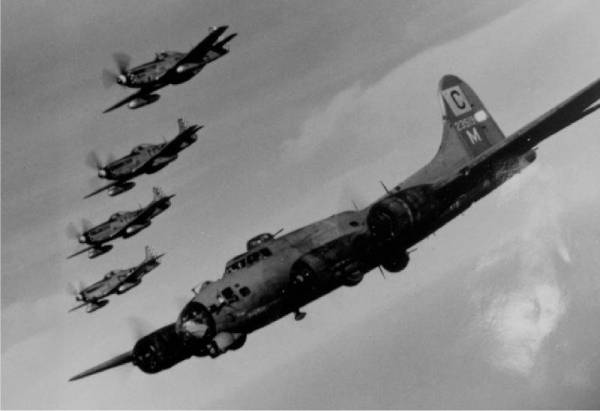
P-51 fighters, equipped with droptanks, fly past the B-17G Pee Wee while on escort duty.
On 20 February 1944 the USAAF again began its campaign to fulfill the POINTBLANK directive. Entitled Operation ARGUMENT, the 8AF and 15AF conducted a week-long series of deep penetration strikes, all escorted by P-51 Mustangs. Targeting German aircraft production centers, the idea was not merely to destroy the factories, but to encourage German fighters to intercept American bombers. Using the bombers as bait, US fighters virtually obliterated the German fighter presence in western-Europe. When the Allied invasion of occupied-Europe finally took place on 6 June 1944, Germany’s air response was non-existent.
Despite some delays between 14 April and 3 September where the US Strategic Air Forces in Europe were placed under Supreme Commander GEN Dwight D. Eisenhower’s control, the US bombing campaign formally began a new campaign against Germany on 12 May 1944. Recognizing Germany’s reliance on foreign oil, the 15AF was to conduct a steady stream of operations against the oilfields of Ploesti, Romania while the 8AF sought out and destroyed German oil refineries, particularly focusing on those plants which distilled coal into oil – the only real domestic source for the substance.
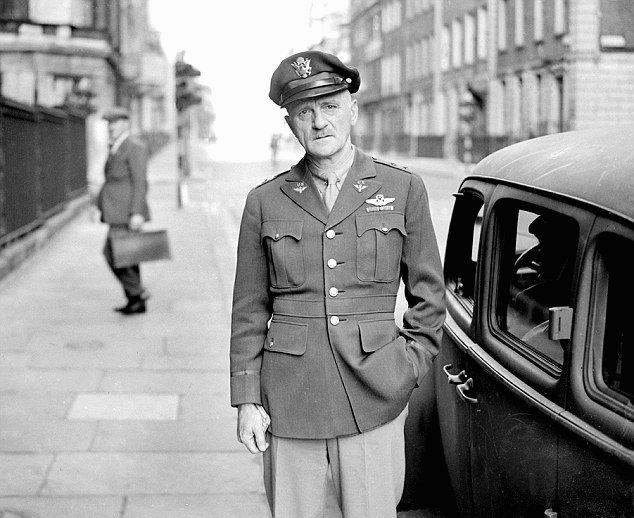
LTG Carl A. Spaatz, CG USSTAF, architect of the oil campaign.
The oil campaign was shockingly effective.
By the end of 1944 the German army was pitifully more reliant on horse drawn equipment than ever before, with vehicles often having to be towed to the battlefield and only started when necessary. Even though the German military remained a fierce opponent, the Allied strategic bombing effort had finally shown itself to have made a real, strategic impact in the war against Germany.
Still, this success came with a heavy cost. The US Army Air Forces at its peak consisted of 79,908 aircraft – the largest air force in history – and of these, 22,948 aircraft were lost in action. Of those aircraft lost, 9,551 were heavy bombers: 27% of the entire American bomber force.
Today we have few surviving US heavy bombers from the Second World War.
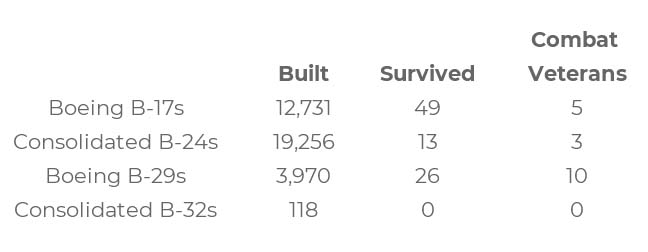
With the war over and left with thousands of unneeded combat aircraft, almost all were scrapped for their aluminum. As such, the vast majority of surviving Second World War aircraft with us today are those that found use doing oddball jobs for the military or on the military-surplus civilian market. And, for aircraft the B-17, the marked preference was for those new aircraft still on the production floor when the war came to an end. It for this reason that actual combat veterans from the Second World War are such a rarity.
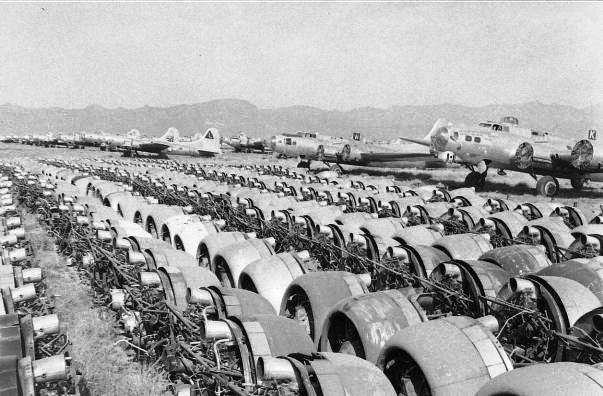
Thousands of bombers await the scrapper’s torch in the years following the Second World War.
While not the most numerous US bomber to see service during the war, the Boeing B-17 nevertheless came to epitomize the USAAF and it sacrifices. Aside from valiant holding actions in the Pacific at the war’s outbreak, the vast majority of B-17s saw action with the 8AF over Europe – the very place where the USAAF put its strategic bombing theories to the test. Noting how thousands gave their lives to bring Germany to its knees in the cause of liberating Europe, surviving B-17 combat veterans are a testament to this war in the air:
- Swoose (40-3097) served with the 19th Bombardment Group in the Philippines at the beginning of the war. She is the only surviving B-17 to have been built in the B-17’s prewar configuration.
- Swamp Ghost (41-2446) served with the 19th Bombardment Group in the Dutch East Indies. She ran out of fuel over Rabaul in New Guinea on 22 February 1942 – her first combat operation.
- Memphis Belle (41-24485) served with the 91st Bombardment Group in Bassingbourn, England. She was the first B-17 in the 8AF to complete 25 missions and return to the US. The Belle flew her final mission on 19 May 1943.
- Shoo Shoo Baby (42-32076) served with the 91st Bombardment Group in Bassingbourn, England. She flew 24 operations with the 8AF from 24 March to 29 May 1944, at which time she crash-landed in neutral-Sweden and was interned.
- Pink Lady (44-8846) served with the 351st Bombardment Group in Polebrook, England. She flew six operations before the war’s end as a radar-equipped “Pathfinder,” afterward staying in Europe for map-making duties.
Of the aircraft listed above, none took part in the bloody campaigns of latter 1943.
It is our intention to rectify this loss.
With your help, we can rebuild the wreckage of Lucky Thirteen and, with it, have a surviving example from those bloody counter-air operations of 1943. Let us remember the sacrifices made in POINTBLANK and the place of honor it holds in history’s largest aerial confrontation.
